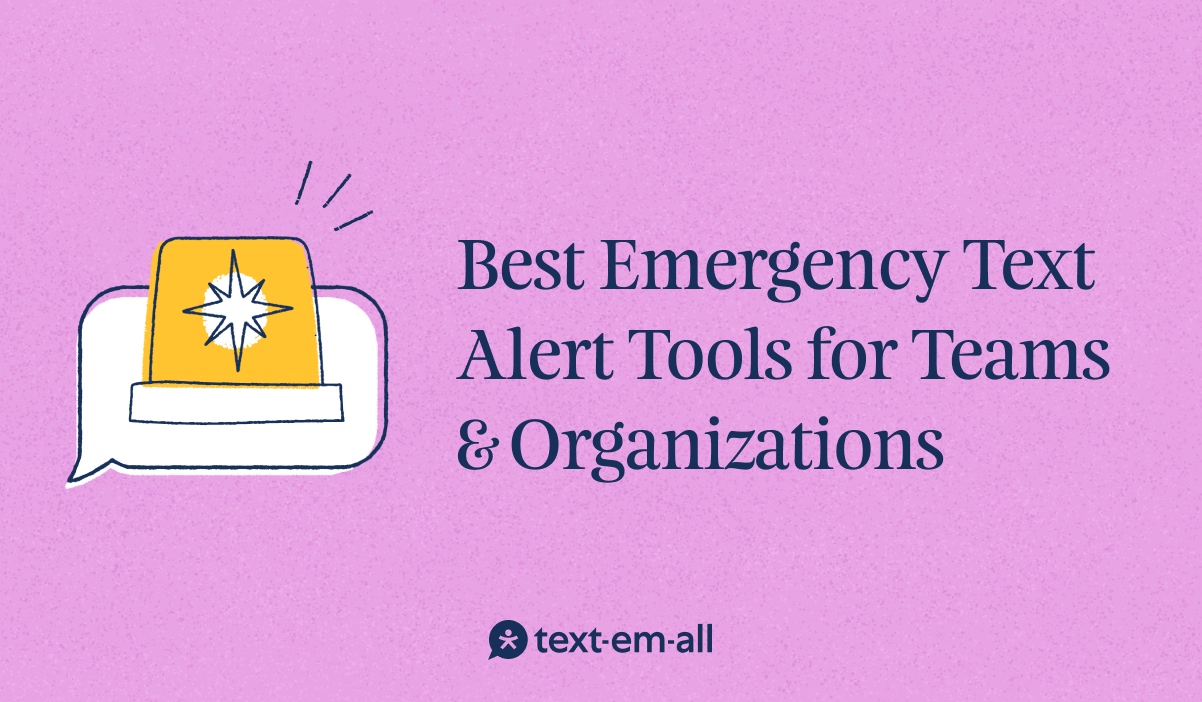
Sign up and register now for free to prevent delays in emergency communication.
Emergencies don’t wait for email. When a storm shuts down power, a chemical spill forces an evacuation, or an IT outage ripples across offices, organizations need a way to connect with people instantly. Emergency text alert systems deliver urgent information where it’s most likely to be seen—directly on a person’s phone.
Unlike apps or email, SMS has near-perfect open rates (98% according to a recent study) and works even when Wi-Fi or data is spotty. That speed and reliability can mean the difference between confusion and safety. For companies spread across multiple sites, nonprofits managing volunteers, or retail stores facing sudden closures, having the right alert tools in place is critical.
Text-Em-All, a trusted emergency text alert platform, makes that process simple, reliable, and scalable.
Why are emergency text alert tools?
Emergency text alert tools are software platforms that let you send urgent SMS messages to groups of people all at once. They’re designed for moments when fast, direct communication matters most.
Why SMS? Texting is:
- Fast: Most messages are read within minutes.
- Reliable: Texts get through even when apps fail.
- Direct: They reach people on the device they check most.
Organizations rely on text alerts for a variety of reasons:
- Severe weather warnings
- Workplace safety incidents
- Volunteer coordination
- IT or system outages
- Last-minute event changes
When email feels too slow and phone trees are too messy, text alerts provide a clear, consistent way to reach everyone who needs to know.
Core features to look for in an emergency text alert system
Not all platforms are built the same. Here are the features that make a difference when every second counts:
- Mass texting capacity: Make sure the platform scales to hundreds or thousands without delay.
- Geo-targeting: Helpful for organizations spread across multiple regions, like municipalities or global enterprises. For most businesses and nonprofits, segmenting groups by role, location, or department offers a simpler and equally effective solution.
- Delivery confirmation: Know who received and opened messages. In a crisis, this accountability proves the message got through.
- Two-way communication: Let staff check in or ask questions. Quick “I’m safe” replies can save hours of uncertainty.
- Role-based permissions: Empower local leaders to act without waiting on corporate approval. A store manager should be able to notify their team immediately.
- Integrations: Connect with HR systems, CRMs, or event tools to save time and reduce manual work.
These features aren’t just nice to have; they’re what separate an effective alert from a missed opportunity.
Which platforms offer the best emergency text alerts?
Several providers stand out for emergency alerts. However, Text-Em-All stands out for its balance of simplicity, compliance, and scale. It’s suitable for both small teams and multi-location organizations. Here’s a quick comparison of other top platforms:
|
Platform |
Geo-targeting |
Delivery confirmation |
Role-based permissions |
What customers like |
Best for |
|
Text-Em-All |
Partial geo-targeting (segments, zip codes etc.), but not real-time geofencing |
Yes |
Yes |
Easy onboarding |
Businesses & nonprofits |
|
AlertMedia |
Yes |
Yes |
Yes |
Mobile app support |
Large enterprises |
|
Everbridge |
Yes |
Yes |
Yes |
Crisis management |
Global operations |
|
OnSolve CodeRED |
Yes |
Yes |
Limited |
Strong weather alerts |
Municipalities and public safety |
|
SimpleTexting |
Partial geo-targeting (segments, zip codes etc.), but not real-time geofencing |
Yes |
Limited |
Group messaging, discounts |
Nonprofits and small businesses |
|
Twilio |
Yes (via APIs) |
Yes (via APIs) |
Yes |
Developer-driven |
Tech-savvy teams and developers |
Takeaway: If you’re an enterprise with a global footprint, Everbridge or AlertMedia might be your fit. If you’re a nonprofit, SimpleTexting offers affordable basics. But if you want a balance of ease, scale, and compliance, Text-Em-All provides the best all-around option that grows with you, whether you’re a small team, a mid-sized organization, or a complex enterprise.
Emergency alerts for multi-location businesses
Imagine managing 500 employees across three different locations during a severe weather event. Sending one blanket message could cause unnecessary panic, but waiting to call each site wastes time.
With Text-Em-All’s mass texting service, you can:
- Geo-target specific sites with audience segmentation, so only impacted teams are alerted.
- View delivery reports to confirm employees got the message.
- Give role-based permissions so site leaders can send local updates instantly.
AlertMedia and Everbridge also support multi-location use cases, but Text-Em-All’s user-friendly dashboard and strong compliance safeguards make it easier for teams of any size to implement.
Weather & event alerts for volunteers and community groups
Volunteer groups need a system that’s simple, not complicated. When a storm cancels a community event or a relief effort relocates, fast delivery and easy onboarding are crucial.
With Text-Em-All, leaders can:
- Send weather alerts to all volunteers in seconds.
- Segment groups by role or location for more targeted communication.
- Onboard new volunteers without complex training.
SimpleTexting and OnSolve also serve this space, but they lack the same scalability. Text-Em-All grows with you, making it a strong long-term choice for nonprofits and community groups.
Store & team-level emergency alerts
Retail and service teams face everyday disruptions like early closures due to weather, safety incidents, or last-minute staffing changes. Waiting on corporate slows response time, which isn’t an option in urgent situations.
Text-Em-All empowers store managers to:
- Alert staff about sudden closures.
- Share urgent shift updates.
- Use two-way texting so employees can quickly confirm they’ve seen the message.
While Twilio and AlertMedia can also support this, Text-Em-All’s simple dashboard and role-based permissions make it easier for non-technical users to manage.
How to choose the right emergency text alert tool
The best choice depends on your needs:
- Businesses: Look for dashboards that support multiple locations, plus delivery confirmation for accountability.
- Nonprofits & volunteers: Prioritize affordability, easy opt-in, and simple group messaging.
- Events: Select tools that allow fast setup and segmentation for participants.
Above all, choose a system you can trust. In an emergency, the tool shouldn’t add stress—it should remove it.
Prepare your team now for the next emergency
In an emergency, speed and accountability save time, protect people, and maintain trust. Platforms like AlertMedia, Everbridge, and CodeRED offer strong capabilities, but Text-Em-All stands out for its combination of scalability, ease of use, and compliance—making it a strong fit for businesses, nonprofits, and event teams alike.
Don’t wait until a crisis to test your system. Prepare your organization today with a reliable, easy-to-use emergency text alert platform. Start mass texting with Text-Em-All.
Frequently asked questions
-
Which platforms offer geo-targeting and delivery confirmation for emergency alerts?
Platforms like Everbridge and AlertMedia are known for advanced geo-targeting and detailed delivery confirmation. Text-Em-All, while not designed for hyper-local geo-targeting, does provide reliable delivery confirmation and strong segmentation features. Instead of drawing a map, you can group contacts by location, role, or custom fields, then send targeted messages to only those segments. This approach gives organizations the targeting benefits of geo-based tools without the added cost or complexity of enterprise-only platforms.
-
What’s the best SMS alert system for volunteer groups and nonprofits?
Text-Em-All and SimpleTexting offer simple onboarding and group messaging; Text-Em-All scales better for larger teams.
-
Can store managers send team alerts without going through corporate?
Yes, Text-Em-All allows role-based permissions so managers can act quickly.
-
How reliable are SMS alerts during severe weather or outages?
SMS is more reliable than email or app notifications, as it doesn’t require internet and has higher delivery rates.
-
Do emergency text alert systems integrate with HR or event software?
Yes, Text-Em-All supports integrations through APIs, making it easy to connect with HR or event platforms.
-
How do emergency alerts differ between SMS, email, and app notifications?
SMS alerts are delivered directly to a person’s phone and are almost always read within minutes. Email is slower and can get buried in crowded inboxes, while app notifications only work if the user has the app installed and notifications enabled. In urgent situations, SMS is the most reliable way to reach the largest number of people quickly.
-
Which mass texting platforms are most affordable for small organizations?
For small businesses, nonprofits, or volunteer groups, cost matters just as much as reliability. SimpleTexting offers discounted nonprofit pricing, while Text-Em-All keeps things straightforward with low monthly plans or flexible pay-as-you-go credits—so organizations only pay for what they use. Text-Em-All’s pricing model makes it easier for small teams to get started without surprise fees.












